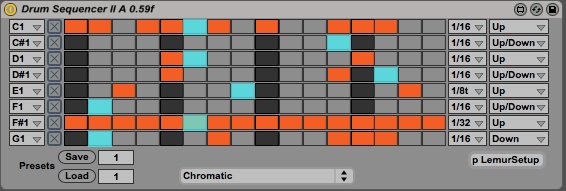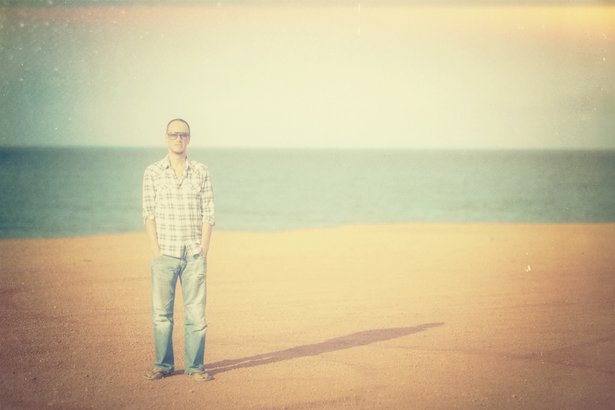With experience as a globe-trotting musician, label-owner, DJ, and sound designer, Mark Barrott is well aware of the feedback loop between music and its contextual (and physical) setting. Originally based in the North of England, Barrott currently resides on the sunny Spanish island of Ibiza, where his neighbors include fellow dance music veterans José Padilla and George Evelyn. It was immersed in these pristine tropical surroundings that Barrott finished his latest album, the aptly named Sketches from an Island, his first full-length release in six years, and his debut under his own name.
We caught up with Mark during a brief sojourn back to his native UK, to discuss the album, working on a bench outside, doing things “in the box”, and the meteoric rise of his label, International Feel.
“Baby Come Home” from Sketches from an Island
Your new album is heavily influenced by your surroundings - how does it work, recording an electronic album in the middle of a beautiful natural area?
If you look at my living situation, I live in the middle of the “Umland”, or countryside, so there’s no ambient noise apart from birdsong, there’s very little road noise, there’s certainly no people noise. I think your environment definitely influences your music making - my environment is very tranquil and it’s very strange when I come to Sheffield to see my parents every couple of months, the level of ambient noise - which to an English person hearing this all day is very acceptable - is to me so loud. I have two sets of custom earplugs that I wear a lot when I’m in England just because the level of ambient noise is incredible. To a degree it’s the same in Berlin, I lived in Berlin for four or five years on and off and the noise in a city is very loud compared to my level of ambient noise at home, so the starting place is a much more meditative space than perhaps it would be if I lived in a city.
What was your technical setup for making Sketches?
The only hardware I used on the album was the Arturia Microbrute, on one song. The actual gear list for this album was a MacBook Pro running Ableton, an iRig, the little IK Multimedia 3 Octave mini keys thing, a pair of Sennheiser headphones, an iLok to authorize some software and right at the very end the Arturia Microbrute on one part on one track. Everything else was totally and utterly in the box in Ableton. This album was made entirely in the box apart from one part on the last track.

Cover art for Sketches from an Island
You mixed the album on headphones - did that make you mobile?
I work in the Wohnzimmer (living room) of wherever I am, I don’t like a set studio. In Uruguay I had a separate studio that was acoustically perfect with a big set of Genelec monitors and I kind of think that music for a musician is so intrinsically linked to their life, you make better music when you’re in the midst of everything. So for example, in the place we were in when I made the majority of the album, there was a big open plan Wohnzimmer and then that’s where I set up and in the new place we’re in we’ve basically got this big old finca [farm] with a modern winter garden on it and we’ve set the whole house up, apart from sleeping, in the winter garden and I’m in there. So in there’s a little kitchen, a sort of settee area, there’s a work area for my wife and my studio area and I like the fact of being there, seeing the cats, watching the sunset, seeing the greenery, rather than being in a little studio tucked away with no natural light.
The majority of this album was made by me sat at an old Ibicenco communal table with the laptop, no mouse - because I think when you use a trackpad it gives you a more intimate relationship with the computer and you focus more on it, it’s one stage less of detachment. I don’t really listen to music other than in headphones. So everything is done in headphones and then I run off stems and I have them stem-mixed by an incredible guy in the south of England in Devon - Lewis Hopkin at Stardelta Mastering.
And you’ll be expanding your gear collection for work on José Padilla’s album?
I’ve said a lot as a quote that, “music technology is a fantastic hobby that often gets in the way of music”. So I’ve got a feeling that I’m going to sit there, a week on Friday, and at my fingertips I’m going to have 2 iPods, a Moog Minitaur, you know 3 other synths on the next rack…let’s see how much of them I use on [José Padilla’s forthcoming album on International Feel], let’s just see…probably not that much, to be quite honest, but I’ll have fun playing with them, much like my dad’s whole life has been vintage cars, and he had cars he had to work on to earn his living and then cars he worked on for fun. Let’s just see how much of this new synth-y stuff that I actually use and I probably know I won’t use it that much but it’ll give me a great degree of pleasure.
When you started International Feel, you were living in Punta Del Este, Uruguay. What brought you there?
Initially we [Mark and his wife] were sat in Heinersdorf and we were in year 4 of a 5 year rental agreement on a really beautiful house so we figured we didn’t want to do another 5 years. We gave our notice and then we sat in the winter garden one afternoon in Spring and just thought: What do we need? Good internet and a few other things, like make sure there’s medical services and clean water and all of that. We just started looking at world maps on the Internet and thought: We both spent a lot of time in Asia, we don’t really want to live there; Australia is too expensive; New Zealand has fucked up quarantine laws for the cat, and so we focused on South America: Brazil didn’t particularly appeal, Chile looked possible but obviously had the problem with the Pacific coast and earthquakes and Tsunamis and then we looked at Uruguay. Two months later we went and spent a week there, we went to Buenos Aires for the weekend and in a moment of madness came back to Uruguay at the end of the week and then bought a house.
We got home at the end of August and thought: Umm, we own a house in Uruguay [laughs]. Funnily enough, in a kind of pre-cursor of the way I now work, I packed in a little setup in a wheelie suitcase, my laptop and a Novation SL-25, and I wrote the first Rocha single while I was waiting for a shipping container to arrive. I couldn’t get a deal for it anywhere and then after that I thought: you know what, I’ll start a label and show all those little bastards how to do it. And then that first single sold 2,500, then I signed Harvey, his single sold 3,000 and here we are 5 years later and I’ve sold 100,000 pieces of vinyl!
DJ Harvey has really had a career resurgence since his remixes and releases on International Feel. How did you first get in contact with him?
It was pretty simple, Harvey was going to come out of international DJ retirement and he was also likely going to produce again. The fact that I lured him out of studio retirement like most things in life - was timing. Like buying a house in Uruguay! I mean I had finished the Rocha track and just thought: “Okay, what am I going to do? Right, I am going to do a 180g vinyl, that’s an easy decision, what else am I going to do? Okay I am going to get some really beautiful artworks.” But is that still enough?
I just started thinking: “Look, if you’re really serious about this and you really want to pay back on your investment and you really want to make a splash, who are the guys?” I drew up a shortlist with people like Jan Hammer or Thomas Dolby. Sometimes when you get demos, it’s like: Hey International Feel, listen to my fucking great new disco dub demo. Hmm, you know what? I’m not even going to listen to that. Or sometimes you get really nice letters, with good music or shit music, but you approach that with open ears. So I thought, when I’m approaching these big potential make-a-splash remixers, that I need to be courteous, I need to be professional, I need to offer a deal that is realistic and not: “Hey, fancy doing it on mate’s rates?” That’s not going to work with these kind of guys, and so I just put together a sensible offer that I sent to Heidi, Harvey’s manager, and she came straight back saying they loved the track and he wants to do it. It was just a combination of being professional, being sensible, being respectful and the timing. And then when we’d done that I said: “Hey, do you want to do a project for us?” And he went: “Yeah, why not.” And there you go.
There’s been a bit of a revival of mid-90s drum & bass - a movement which you were originally a part of.
Hasn’t there! What I’ve heard, I don’t call it drum and bass - I call it ambient music with breakbeats, that’s the kind of drum and bass I like. It’s still got a timeless quality about it. I’ve still got a fair few unreleased drum and bass tracks that I did think about just dropping on the grounds of: “Hey, I’m a balearic record label I can release whatever I want, let’s really see how people are prepared to take that.” Let’s release a drum & bass track on International Feel and just see what happens. So I might do that, you never know!
And would you do it under your name or would you bring back Future Loop Foundation?
Oh I don’t know. I think Future Loop Foundation is gone. Something I always live by is: Learn from the past, look into the future and live in the present. So I never really look back. Regardless of whether an individual believes in reincarnation, I believe in reincarnation within this life. There was the me at school, me as a toddler, the me working in a horrible office job in my early 20s, me as Future Loop Foundation, me as International Feel, me in an unhappy marriage, me moving to Uruguay, you know there’s all different phases in your life and Future Loop Foundation is kind of gone so I have no real desire to go back there. I really like to look forward…

Mark Barrott’s custom step sequencer for Max for Live, developed by Bjorn Vayner.
Lastly, you commissioned some Max for Live step-sequencer devices from Bjorn Vayner and have generously agreed to share them. Can you tell us about them?
It’s a bunch of sequencers where you can either use just one, or you can use up to four for your drum programming or melodic work; you can set individual lanes, individual timing, other individual parameters, and you can save it within the patch in Ableton. I use it a lot on the album to get the polyrhythmic African rhythms and it’s a very inspiring thing that I’m really happy to share it because I’m not a big believer in occult information – and I use the word “occult” to mean “hidden” information. I think everything is out there and everything should be shared, but if people want to get the most out of these sequencers, they’re idiot-proof, you don’t need a manual but you’ve got to be curious. Press the screen and see what happens!
Download Bjorn’s custom step sequencers (and Lemur templates)
Sketches from an Island - Mark Barrott’s blog


